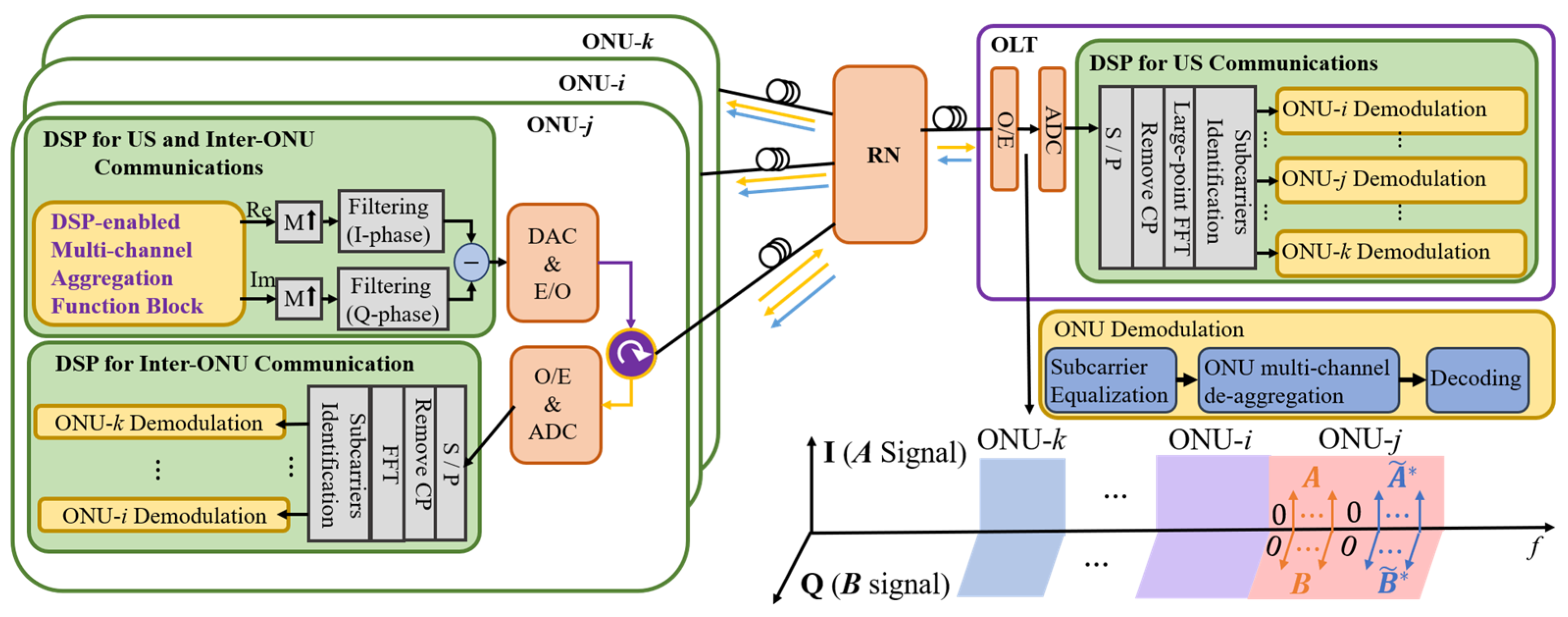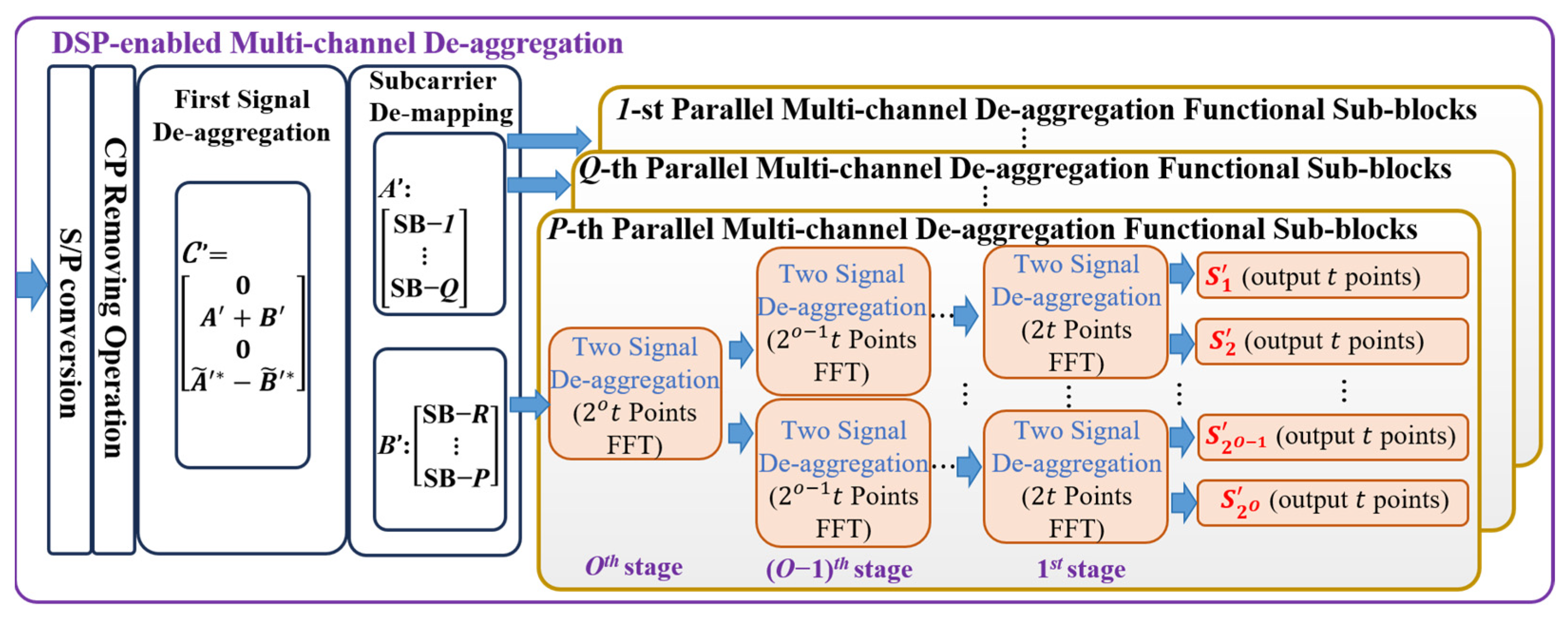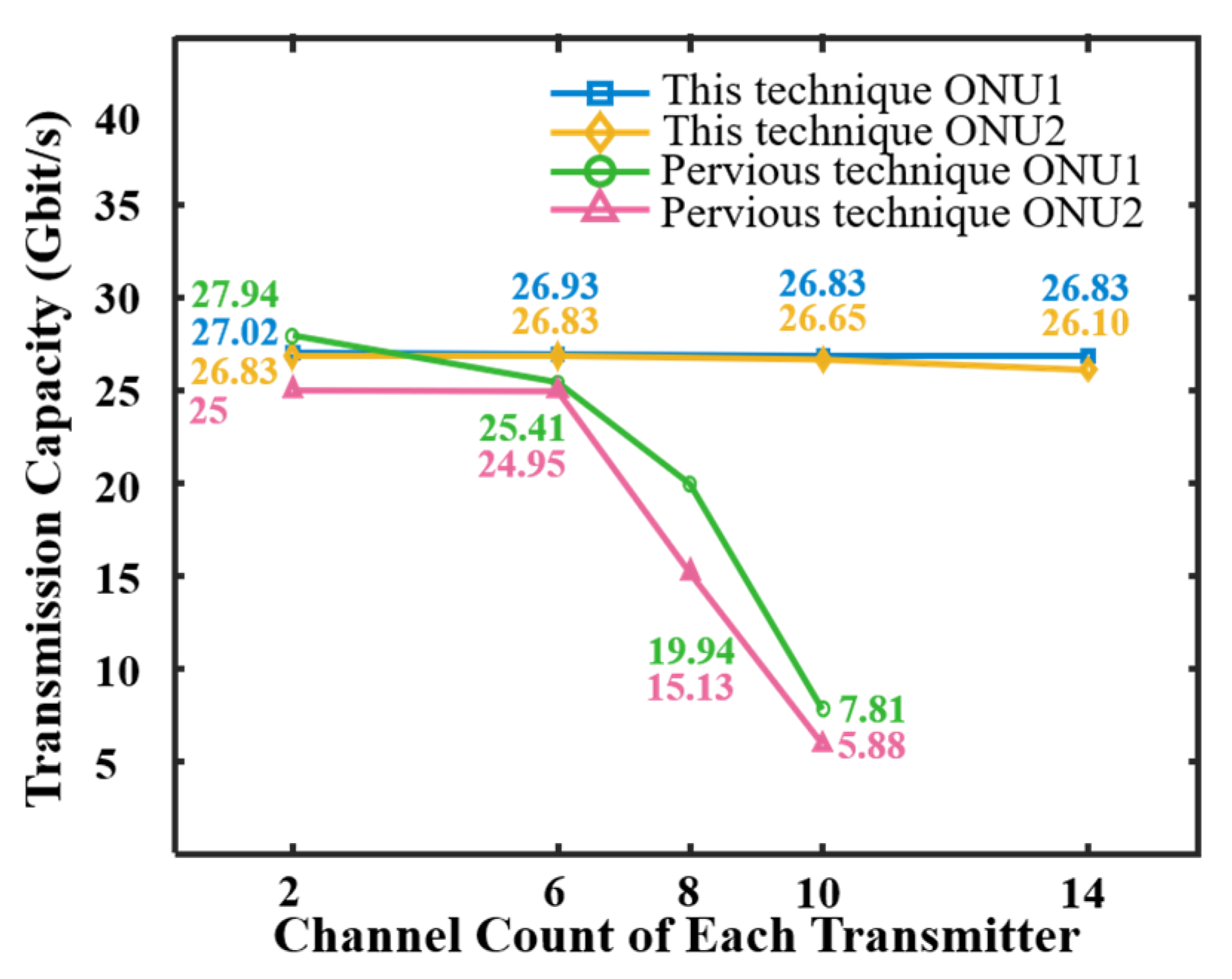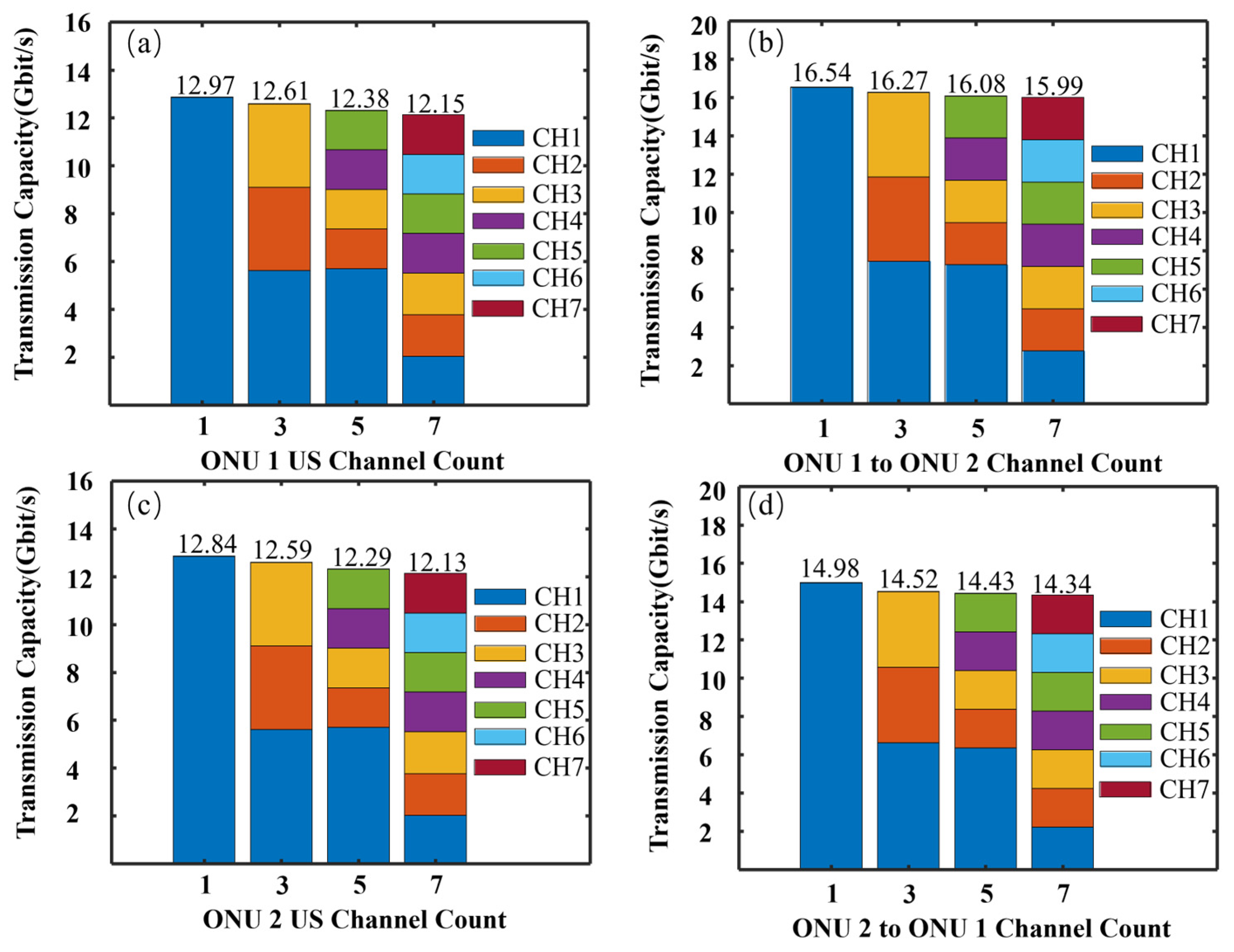1. Introduction
In comparison with 5G networks, 6G networks are envisaged to have considerably enhanced signal transmission capacities and network operation flexibility in order to dynamically provide high-speed, low-latency and on-demand connections capable of supporting a vast number of applications with diverse requirements regarding traffic characteristics [
1,
2,
3]. For practically implementing 6G access networks, intensity modulation and direct detection (IMDD) passive optical networks (PONs) have been widely considered to be a cost-effective solution for deploying their fronthaul links between a baseband unit (BBU) and remote radio heads (RRHs) [
4,
5], where the PON’s optical line terminal (OLT) and optical network units (ONUs) are often located in the BBU and RRHs, respectively. In such a PON-based 6G access network, for many latency-sensitive applications such as industrial automation [
6,
7], end-users need to communicate directly with each other without involving the OLT. However, in a conventional PON, to establish communications between end-users, user data from the source ONU needs to be sent to the OLT before reaching the destination ONUs. This gives rise to a round-trip fiber propagation delay that may be comparable to the latency introduced by corresponding high-layer protocols [
8].
To cost-effectively address the above technical challenges, a concurrent upstream and direct inter-ONU communication IMDD PON has been reported recently [
9], where, in addition to upstream communications from the ONUs to the OLT, highly desired direct inter-ONU communications can also be dynamically established between different ONUs within the same PON without involving the OLT. This is achieved by utilizing a passive optical coupler (OC)-based remote node (RN) to enable the RN to redirect and broadcast the inter-ONU communication signals from the source ONUs to the destination ONUs, while still passing all the ONU’s upstream signals to the OLT [
9]. In addition, the cost-effectiveness and network operation flexibility of the PON can also be further improved if, in each individual ONU and OLT, use is made of a point-to-multipoint (P2MP) optical transceiver incorporating cascaded multi-channel aggregation/de-aggregation operations based on inverse fast Fourier transform (IFFT)/fast Fourier transform (FFT) [
9,
10].
However, to practically implement the P2MP optical transceiver-based concurrent upstream and direct inter-ONU communication IMDD PONs in latency-sensitive and ultra-dense connection application scenarios, three major technical barriers must be overcome, of which two are related to the P2MP optical transceiver design, and one is associated with the RN architecture. Firstly, in the previously reported P2MP optical transceivers, the cascaded multi-channel aggregation/de-aggregation process can just aggregate/de-aggregate a single channel at each stage, the simultaneous accommodation of ultra-dense connections requires a large number of channel aggregation/de-aggregation stages to be cascaded. Considering the fact that the IFFT/FFT size of each stage increases exponentially with channel count [
10], the aggregation/de-aggregation of a large number of channels unavoidably leads to extremely high transceiver DSP complexity. Secondly, when the channel count is large, the channel interference effect becomes non-negligible, thus degrading the overall transmission performances of both the P2MP optical transceivers and the PON [
10]. Thirdly, in the experimental demonstrations reported in [
9], a 3-by-
N OC-based RN [
11,
12,
13] is utilized, which introduces an unacceptable inter-ONU signal power loss of as high as 49.3 dB for cases where 128 ONUs are accommodated because the inter-ONU signals pass the RN twice. Of equal importance is the fact that the inter-ONU signal power loss increases with increasing ONU count.
To cost-effectively overcome the aforementioned three technical barriers, this paper proposes and experimentally demonstrates the effectiveness of a novel P2MP optical transceiver, termed as a new P2MP transceiver, throughout the paper, for implementation in the concurrent upstream and direct inter-ONU communication IMDD PON. The new P2MP transceiver employs (1) a parallel channel aggregation/de-aggregation operation to allow multiple (>2) parallel channels to be aggregated/de-aggregated at each stage and (2) advanced extended Gaussian function (EGF)-based rectangular orthogonal digital filters [
14] for locating signals at the desired radio frequency (RF) spectral regions. Compared to the previously reported P2MP optical transceiver [
9,
10], the new design can not only reduce the overall transmitter (receiver multi-channel de-aggregation) DSP complexity by >75% (>40%) but also equip the demonstrated PONs with significantly enhanced network operation flexibility and performance robustness. Finally, effort is also made to experimentally evaluate a modified RN architecture suffering significantly low inter-ONU signal power loss in an environment capable of supporting 128 ONUs. As such, this work effectively addresses the aforementioned three technical barriers associated with the previously reported techniques [
9,
10], which is the main novelty and contribution of this work.
By incorporating the new P2MP optical transceivers in both the ONUs and OLTs, as well as the modified RN architecture, in this paper, a 27 km, >54.31 Gbit/s concurrent upstream and direct inter-ONU communication IMDD PON is experimentally demonstrated, for the first time, based on which comprehensive experimental explorations of the new P2MP optical transceivers and the modified RN architecture are undertaken. Our experimental results indicate that the proposed PONs allow each ONU to flexibly change its inter-ONU and upstream channel counts without considerably compromising its maximum achievable transmission capacities. Compared to previously reported results [
9], the PON is superior in terms of ensuring low DSP complexity, highly robust transmission performance, and improved network operation flexibility.
Comprehensive comparisons of the techniques of various concurrent inter-ONU and upstream communication IMDD PONs incorporating OC-based RNs and different optical transceivers [
9,
11,
12,
13,
15,
16,
17] are presented in
Table A1 in
Appendix A. In comparison with other existing inter-ONU communication PONs’ RN designs using optical switches [
18,
19], cyclic arrayed waveguide gratings [
20,
21], cascaded optical interleavers [
22], and their combinations [
23], the OC-based modified RNs considered in this work are simple, low-cost, and transparent to wavelengths.
3. New P2MP Transceiver-Induced Performance Improvements
To evaluate the new P2MP transceivers, this section details how we utilized a 25 km, >53.9 Gbit/s IMDD upstream PON, as illustrated in
Figure 5, to experimentally compare the performances between the proposed new P2MP transceiver and the previously reported P2MP transceivers in [
9,
10].
3.1. Experimental Setups and Parameters
At the transmitter side, a dual-channel arbitrary waveform generator (AWG) generates two ONU upstream signals. The signal of ONU1 (ONU2) occupies a spectral region between 0 GHz and 6.25 GHz (6.25 GHz to 12.5 GHz). For the new P2MP transceivers, each ONU transmits 14 independent channels. For each ONU, the
A and
B signals have identical subcarrier allocations, i.e., of the 31 available subcarriers, 7 subcarriers are allocated for a single channel (CH1), 16 subcarriers are used to convey two channels (CH2 and CH3, with four input samples/channel) aggregated by a single eight-point IFFT operation, and the remaining 8 subcarriers are allocated for four channels (CH4 and CH5, as well as CH6 and CH7, with four input samples per channel) aggregated by implementing two stages of IFFT operations with operation sizes of 8 and 16, respectively. After multi-channel aggregation, each ONU applies a digital up-sampling operation, an EGF-based orthogonal digital filtering operation, a 1.2× digital oversampling operation, an ONU timing adjustment operation, and a signal clipping operation. The key parameters are listed in
Table 1, in which the EGF digital filter parameters identified in [
14] are optimum. The channel bitrates of each ONU are summarized in
Table 2.
For the previously reported P2MP transceivers, when the channel count exceeds eight, their transmission performances are significantly degraded [
10]. To fairly compare the new P2MP transceivers with the previously reported P2MP transceivers, each ONU transmits four channels, which are aggregated by performing three cascaded IFFT operations with operation sizes of 16, 32, and 64, respectively. The corresponding channel input sample counts are 8, 8, 16, and 32, respectively. After multi-channel aggregation, the remaining DSP procedures are similar to the new P2MP transceivers, apart from the fact that square-root-raised-cosine (SRRC) digital filters are used in orthogonal digital filtering. The optimum SRRC digital filter parameters, identified in [
9,
10], are listed in
Table 1. The resulting channel bitrates are listed in
Table 3.
Two optical transmitters, each with a laser and a Mach–Zehnder modulator (MZM), are used to perform intensity modulation. The two optical signals produced have a ~0.8 nm wavelength spacing to eliminate the optical beating interference effect. After that, for each ONU, an erbium-doped fiber amplifier (EDFA) and a tunable optical filter (TOF) are used to set the ONU launch power at 5 dBm.
At the receiver, a PIN photodetector converts the received optical signals to an electrical signal, which is then digitized by an oscilloscope. The demodulation DSP procedures include digital-domain signal sampling adjustments, serial-to-parallel (S/P) conversions, CP removals (32 samples for both of the considered transceivers), a single 256-point FFT operation (for both of the considered transceivers), subcarrier equalization, ONU multi-channel de-aggregation, and m-QAM decoding. In addition, the AWG-embedded pre-compensation functions are also used to flatten the overall network frequency responses.
For the proposed PONs, different ONUs use different wavelengths. When the ONU wavelength spacing is large enough to accommodate laser frequency drifting and position the optical beating interference noises at high frequencies beyond the bandwidth of the receiver photodetector, each ONU can use free-running lasers without locking their laser frequency.
3.2. Improved Upstream Transmission Performance
Based on the experimental setup shown in
Figure 5, the upstream transmission performances of the two considered transceivers are presented in
Figure 6. Adaptive bit-loading was used to ensure that all the channels conveyed by these two transceivers have similar upstream receiver sensitivities, i.e., the minimum received optical powers required to achieve bit error rates (BERs) of 2 × 10
−2 at the forward error correction (FEC) limit [
10]. For the previously reported P2MP transceivers, since all the channels exhibit similar BER performances, for simplicity, only the BER performance of CH1 is plotted in these figures.
It can be observed from
Figure 6 that for the new P2MP transceivers, the channels of the same subcarrier group, such as CH2 and CH3, have similar bitrates and BER performances, as well as similar multi-channel aggregation/de-aggregation DSP latencies. Depending on parallel multi-channel aggregation sub-block configurations, the channels at different subcarrier groups can have different bitrates/bandwidths and multi-channel aggregation/de-aggregation DSP latencies. For example, CH1 has the lowest latency and highest bitrate, whist CH4 has the highest latency and lowest bitrate, and CH3 has a moderate latency and bitrate. On the other hand, for the previously reported P2MP transceivers, the channels aggregated at the earlier (later) channel aggregation stage, such as CH1 (CH4), always have smaller (larger) bandwidths and larger (smaller) latencies. More importantly, the new P2MP transceivers can support more channels with highly robust transmission performance, as verified in
Section 3.3. Therefore, to satisfy end-user’s dynamic needs, the new P2MP transceivers can equip the proposed PONs with improved capabilities of flexibly providing ultra-dense on-demand connections with variable latencies.
3.3. Channel Count-Dependent Performance Comparison
Based on the experimental setup described in
Section 3.1, this section experimentally evaluates the impact of channel count variations on the maximum achievable aggregated upstream transmission capacities of the considered two P2MP transceivers. The received optical power is fixed at −5 dBm. The results are presented in
Figure 7.
It can be found from
Figure 7 that for the previously reported P2MP transceivers, increasing the channel count to >8 leads to a considerable reduction in the maximum achievable aggregated upstream transmission capacity. This agrees with the result in [
10]. This is because an increase in channel count leads to more pronounced channel interference [
10]. While for the new P2MP transceivers, increasing the channel count to 14 can only cause a <0.7% reduction in the aggregated upstream transmission capacities. This implies that the new P2MP transceivers can support more channels with highly robust transmission performances, as also suggested by the results in
Section 4.3.
3.4. Transceiver DSP Complexity Comparison
Based on the theoretical analyses in
Section 2.3, the transmitter DSP complexities of the two transceivers were calculated, and the results are presented in
Figure 8.
Figure 8a shows the multi-channel aggregation DSP complexity only (excluding digital filter DSP complexity).
Figure 8b plots the overall transmitter DSP complexity, including both the multi-channel aggregation and digital filter DSP complexities. To highlight the new transceiver’s advantages in considerably reducing the DSP complexity, the DSP complexity ratios between the new transceivers and the previous transceivers are also illustrated in these figures. The up-sampling factor of
M is 256, and the PONs are assumed to accommodate 128 ONUs. All other parameters that are not mentioned above are listed in
Table 1.
The results in
Figure 8a show that as the channel count increases, the superiority of the new P2MP transceivers in reducing the multi-channel aggregation DSP complexity becomes more pronounced. On the other hand, the new transceivers employ EGF-based digital filter banks, which, compared to the previously reported P2MP transceivers’ SRRC filters, can reduce the optimum digital filter length by a factor of 4 [
14]. Therefore, as shown in
Figure 8b, the new P2MP transceivers can reduce the overall transmitter DSP complexity by >75%, which is almost independent of channel count.
It is also worth mentioning that because the receiver multi-channel de-aggregation DSPs are inverse to the transmitter’s counterparts, the new P2MP transceiver-induced reductions in the receiver multi-channel de-aggregation DSP complexity are similar to those in
Figure 8a.
4. Experimental Demonstrations of Concurrent Direct Inter-ONU and Upstream Communication IMDD PONs
To experimentally evaluate the concurrent direct inter-ONU and upstream communication IMDD PON incorporating the new P2MP transceivers and the modified RNs, in this section, a 27 km, >54.31 Gbit/s upstream IMDD PON is considered, as shown in
Figure 9. As shown in the figure, the RN is constructed by 128-port OCs, suggesting that the PON can accommodate 128 ONUs. Due to the lack of key experimental devices, for simplicity, these 128-port OCs are constructed using multiple OCs. For the experimental setup, the ONU optical launch power is 6.6 dBm, while all other key experiment parameters, including the AWG/oscilloscope sampling speed and the MZM/laser/EGF filter parameters, are similar to those listed in
Table 1.
4.1. Experimental Setups and Parameters
A dual-channel AWG is used to produce two ONU signals, each containing six independent channels (three for upstream communications and three for inter-ONU communications). In each ONU’s transmitter DSP, for simplicity, the A and B signals are used for the upstream and inter-ONU communications, respectively, and they employ similar subcarrier allocations. Among the overall 31 subcarriers, 15 subcarriers are allocated for a single channel (CH1), and the remaining 16 subcarriers are used for conveying two channels (CH2 and CH3, with eight input samples per channel, aggregated via a 16-point IFFT operation).
After multi-channel aggregation, similar to that mentioned in
Section 3.1, the following transmitter DSP procedure is adopted, which includes an EGF-based orthogonal digital filtering operation, a 1.2× digital oversampling operation, an ONU timing adjustment operation, and a signal clipping operation. The resulting channel bitrates, the ONU bitrates, and the aggregated overall transmission bitrates, are summarized in
Table 4.
The OLT’s upstream communication receiver and the ONU’s inter-ONU communication receivers have similar configurations and DSP procedures, apart from the fact that each ONU receiver employs an extra TOF to remove unwanted wavelengths (i.e., its upstream wavelength). The receiver DSP procedure includes sampling adjustments, S/P conversions, CP removals, a 256-point FFT operation, subcarrier equalizations, parallel multi-channel de-aggregations, and m-QAM decoding. In addition, the AWG-embedded pre-compensation functions are also used to flatten the upstream communication frequency response of the considered PONs.
For the considered experimental setups, the modified RN introduces ~28 dB optical power losses for the upstream signals and ~34 dB power losses for the inter-ONU communication signals. The measured inter-ONU signal power losses are slightly larger than the corresponding theoretically estimated value of 32.65 dB, as mentioned in
Section 2.1, due to the cascading connections of multiple OCs (required for constructing the 128-port OC) and the used optical circulators. On the other hand, when the considered 128-port OCs is used to construct the RNs of the conventional inter-ONU communication PONs [
11,
12,
13], the resulting inter-ONU signal power losses are ~52 dB (inter-ONU signals pass a 128-port OC twice), which also agree with the theoretically estimated value of 49.3 dB in [
9]. As such, the experimental results confirm the validity of both the RN power loss analyses in
Section 2.1 and the superiority of the modified RNs over the conventional OC-based inter-ONU PON RN designs [
11,
12,
13] in reducing inter-ONU signal power losses.
4.2. Upstream and Direct Inter-ONU Communication Transmission Performances
Considering the above experimental setup and parameters, the BER performances of the concurrent upstream and inter-ONU communications are presented in
Figure 10, where adaptive bit-loading is used to ensure that the two ONUs have similar upstream and inter-ONU transmission performances.
As shown in
Table 4, for each ONU, the upstream channels conveyed by the
A signal and the inter-ONU channels conveyed by the
B signal have similar transmission bitrates. However, in comparison with the upstream channels, the inter-ONU channels exhibit ~6 dB receiver sensitivity improvements; this is due to the reduced fiber transmission distance-induced effective mitigations in the channel fading effect. This implies that the demonstrated PONs are promising for offering high transmission capacity and low-latency direct inter-ONU communication services for end-users within the same PONs.
When the received optical powers are >−8 dBm, the inter-ONU channels show BER floors. This is because the pre-compensation operation for flattening upstream communication frequency responses, as mentioned in
Section 4.1, causes unwanted inter-ONU signal distortions, as verified by the electrical signal spectra shown in
Figure 9(IV), where the ONU1-received inter-ONU signal spectrum is not flat. This can be effectively mitigated using post-compensation techniques, where the receivers adapt their embedded equalizers according to the actual distortions of their received signals.
In addition, for the considered experimental setups, the inter-ONU signals experience negligible Rayleigh and Brillouin backscattering effects because (1) the backscattered optical noises produced by the distribution fibers, i.e., fibers between each ONU and the RN, are removed by the TOF used in each ONU, and (2) the RN introduces a large power loss for the backscattered optical noises produced by the feeder fibers, i.e., fibers between the RN and the OLT. This statement is verified by
Figure 9(III), where the Brillouin backscattering effect-produced power peak is invisible at ~10.8 GHz [
9].
The upstream signals also experience negligible Rayleigh and Brillouin backscattering effects because (1) the RN introduces a large power loss for the backscattered optical noises produced by the distribution fibers and (2) because no downstream signals are transmitted in this experimental setup. For practical applications, the downstream and upstream/inter-ONU signals can utilize different wavelengths to mitigate the effects of Rayleigh and Brillouin backscattering.
4.3. Flexible Variations in Upstream and Inter-ONU Communication Channel Count
Utilizing the experimental setup presented in
Section 4.1, the impact of upstream and inter-ONU channel count variations on maximum achievable upstream and inter-ONU transmission capacities was evaluated, and the results are presented in
Figure 11. The received optical power for the upstream (inter-ONU) communications is fixed at −2 dBm (−7 dBm). In the figure, for each considered channel count of
N (
N = 1, 3, 5, and 7), the
A and
B signals of each ONU are used to convey
N upstream channels and
N independent inter-ONU channels, respectively.
It can be found that increasing each ONU’s inter-ONU and upstream channel count from 1 to 7 just slightly reduces its achievable upstream and inter-ONU transmission capacities by <6.4%. This indicates that the proposed PONs allow each ONU to flexibly change its upstream and inter-ONU channel count without significantly compromising its achievable transmission capacities.
Considering a standard 128-port OC with a typical loss uniformity of 2.8 dB, the modified RNs can introduce ~2.8 dB power loss differences for different ONU signals (for both the inter-ONU signals and the upstream signals). The ONUs experiencing relatively large power losses suffer from the degraded transmission performance. As such, ONU power equalization techniques [
26] can be practically applied to reduce the received optical power differences between different ONUs.
For the demonstrated PONs, the inter-ONU and upstream communications employ a set of wavelengths, and each ONU’s inter-ONU and upstream data is modulated on its allocated wavelength. The downstream communication can use different wavelengths to reduce unwanted interferences between inter-ONU, downstream, and upstream communications.
5. Conclusions
This paper has experimentally demonstrated a novel concurrent direct inter-ONU and upstream communication IMDD PON, redesigning the P2MP optical transceiver DSPs. Compared to the previously reported P2MP transceiver DSP designs, the new design can not only lead to a >75% (>40%) reduction in the overall transmitter (the receiver multi-channel de-aggregation) DSP complexity but also enhance the demonstrated PON’s capability of providing on-demand ultra-dense connections.
Detailed experimental evaluations of the demonstrated PONs were undertaken using a 27 km, >54.31 Gbit/s upstream IMDD PON, whose RN was constructed by 128-port OCs capable of supporting 128 ONUs. The experimental results indicate that the PONs allow each ONU to flexibly change their upstream and inter-ONU channel counts without considerably compromising their achievable inter-ONU and upstream transmission capacities.
Overall, the demonstrated PONs outperform those of previously reported works in terms of ensuring low DSP complexity, highly robust transmission performance, and an enhanced capacity to flexibly accommodate numerous applications with diverse requirements.
The real-time implementation of the new transceivers, as well as their implementation in concurrent inter-ONU and upstream communication IMDD PONs, is currently being undertaken in our labs, and the corresponding results will be published in due course.

















